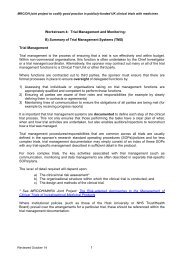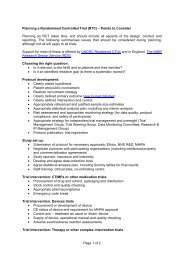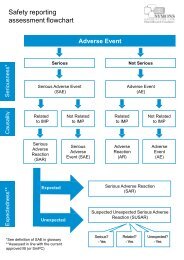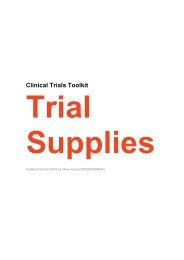Monitoring Procedures Workstream Document (PDF, 379.02 KB)
Monitoring Procedures Workstream Document (PDF, 379.02 KB)
Monitoring Procedures Workstream Document (PDF, 379.02 KB)
You also want an ePaper? Increase the reach of your titles
YUMPU automatically turns print PDFs into web optimized ePapers that Google loves.
MRC/DH joint project to codify good practice in publicly-funded UK clinical trials with medicines<br />
Appendix 2 of the MRC/DH/MHRA document outlines the implications of the IMP risk category<br />
for the monitoring of participant safety and the clinical trial and gives further information on the<br />
types of monitoring and the documentation of all aspects of the monitoring process.<br />
The remainder of this document expands on some of the aspects of monitoring that are<br />
outlined in MRC/DH/MHRA: The Risk-adapted Approaches to the Management of Clinical<br />
Trials of Investigational Medicinal Products.<br />
2. Types of <strong>Monitoring</strong><br />
There are a number of approaches to trial monitoring available, and the procedures for each trial<br />
should be considered as the trial is being developed. Some of these approaches are outlined<br />
below.<br />
2.1 Trial Oversight Committees<br />
The funding body or sponsor may specify particular oversight arrangements, but even if they do<br />
not, some form of oversight is strongly recommended for all trials, although the appropriate<br />
structures will vary according to the size, complexity and risks associated with the trial 3 .<br />
Commonly employed oversight committees for a phase III trial include:<br />
i) Trial Management Group (TMG)<br />
ii) Trial Steering Committee (TSC)<br />
iii) Data <strong>Monitoring</strong> Committee (DMC)<br />
Trial Management Group: Most trials should have a TMG, although in very small simple trials<br />
the Chief Investigator may perform the functions of the trial management group. The TMG<br />
should include those individuals responsible for the day-to-day management of the trial, such as<br />
the Chief Investigator, statistician, trial co-ordinator, research nurse, data manager, as relevant.<br />
The group should keep a close eye on all aspects of the conduct and progress of the trial,<br />
ensure that the protocol is adhered to and take speedy action as necessary to safeguard<br />
participants and the trial itself.<br />
As a trial increases in size and complexity, more formal structures become appropriate. In singlecentre<br />
trials, oversight may be provided through the research governance arrangements made by<br />
an NHS Trust/Health Board or university. In larger trials a Trial Steering Committee is<br />
recommended.<br />
Trial Steering Committee: The role of a TSC is to provide overall supervision of the trial and<br />
ensure that it is being conducted in accordance with the principles of Good Clinical Practice and<br />
the relevant regulations. Formalised procedures should be in place directing its formation and<br />
membership as well as its agreed responsibilities.<br />
The TSC should agree the trial protocol and any protocol amendments and provide advice to<br />
investigators on all aspects of the trial. The TSC monitors the progress of a trial including the<br />
recruitment, data completeness, and losses to follow-up and ensures that there are no major<br />
deviations from the trial protocol.<br />
A TSC will usually have members who are independent of the investigators; an independent<br />
chairperson in particular can be very helpful, as well as two other independent members 4 .<br />
The documentation produced by the TSC will include details of key decisions made during the<br />
trial and should be archived in the Trial Master File.<br />
3 The MRC Guidelines for Good Clinical Practice in Clinical Trials (1998) give further information relating to<br />
oversight committees.<br />
4 Extract taken from Appendix 3 of MRC Guidelines for Good Clinical Practice in Clinical Trials (1998)<br />
which also provides information for the TSC Terms of Reference.<br />
Updated November 2012 2







